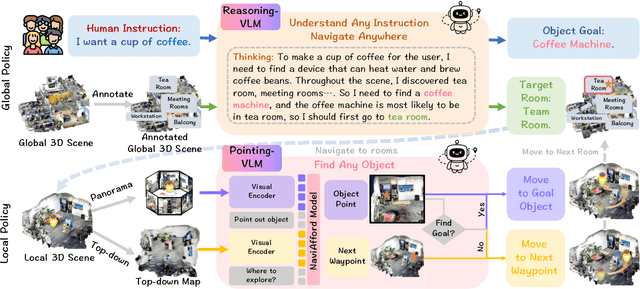Yingbo Tang
Team Xiaomi EV-AD VLA: Learning to Navigate Socially Through Proactive Risk Perception - Technical Report for IROS 2025 RoboSense Challenge Social Navigation Track
Oct 09, 2025Abstract:In this report, we describe the technical details of our submission to the IROS 2025 RoboSense Challenge Social Navigation Track. This track focuses on developing RGBD-based perception and navigation systems that enable autonomous agents to navigate safely, efficiently, and socially compliantly in dynamic human-populated indoor environments. The challenge requires agents to operate from an egocentric perspective using only onboard sensors including RGB-D observations and odometry, without access to global maps or privileged information, while maintaining social norm compliance such as safe distances and collision avoidance. Building upon the Falcon model, we introduce a Proactive Risk Perception Module to enhance social navigation performance. Our approach augments Falcon with collision risk understanding that learns to predict distance-based collision risk scores for surrounding humans, which enables the agent to develop more robust spatial awareness and proactive collision avoidance behaviors. The evaluation on the Social-HM3D benchmark demonstrates that our method improves the agent's ability to maintain personal space compliance while navigating toward goals in crowded indoor scenes with dynamic human agents, achieving 2nd place among 16 participating teams in the challenge.
$NavA^3$: Understanding Any Instruction, Navigating Anywhere, Finding Anything
Aug 06, 2025



Abstract:Embodied navigation is a fundamental capability of embodied intelligence, enabling robots to move and interact within physical environments. However, existing navigation tasks primarily focus on predefined object navigation or instruction following, which significantly differs from human needs in real-world scenarios involving complex, open-ended scenes. To bridge this gap, we introduce a challenging long-horizon navigation task that requires understanding high-level human instructions and performing spatial-aware object navigation in real-world environments. Existing embodied navigation methods struggle with such tasks due to their limitations in comprehending high-level human instructions and localizing objects with an open vocabulary. In this paper, we propose $NavA^3$, a hierarchical framework divided into two stages: global and local policies. In the global policy, we leverage the reasoning capabilities of Reasoning-VLM to parse high-level human instructions and integrate them with global 3D scene views. This allows us to reason and navigate to regions most likely to contain the goal object. In the local policy, we have collected a dataset of 1.0 million samples of spatial-aware object affordances to train the NaviAfford model (PointingVLM), which provides robust open-vocabulary object localization and spatial awareness for precise goal identification and navigation in complex environments. Extensive experiments demonstrate that $NavA^3$ achieves SOTA results in navigation performance and can successfully complete longhorizon navigation tasks across different robot embodiments in real-world settings, paving the way for universal embodied navigation. The dataset and code will be made available. Project website: https://NavigationA3.github.io/.
RoboBrain 2.0 Technical Report
Jul 02, 2025Abstract:We introduce RoboBrain 2.0, our latest generation of embodied vision-language foundation models, designed to unify perception, reasoning, and planning for complex embodied tasks in physical environments. It comes in two variants: a lightweight 7B model and a full-scale 32B model, featuring a heterogeneous architecture with a vision encoder and a language model. Despite its compact size, RoboBrain 2.0 achieves strong performance across a wide spectrum of embodied reasoning tasks. On both spatial and temporal benchmarks, the 32B variant achieves leading results, surpassing prior open-source and proprietary models. In particular, it supports key real-world embodied AI capabilities, including spatial understanding (e.g., affordance prediction, spatial referring, trajectory forecasting) and temporal decision-making (e.g., closed-loop interaction, multi-agent long-horizon planning, and scene graph updating). This report details the model architecture, data construction, multi-stage training strategies, infrastructure and practical applications. We hope RoboBrain 2.0 advances embodied AI research and serves as a practical step toward building generalist embodied agents. The code, checkpoint and benchmark are available at https://superrobobrain.github.io.
Video-CoT: A Comprehensive Dataset for Spatiotemporal Understanding of Videos Based on Chain-of-Thought
Jun 12, 2025Abstract:Video content comprehension is essential for various applications, ranging from video analysis to interactive systems. Despite advancements in large-scale vision-language models (VLMs), these models often struggle to capture the nuanced, spatiotemporal details essential for thorough video analysis. To address this gap, we introduce Video-CoT, a groundbreaking dataset designed to enhance spatiotemporal understanding using Chain-of-Thought (CoT) methodologies. Video-CoT contains 192,000 fine-grained spa-tiotemporal question-answer pairs and 23,000 high-quality CoT-annotated samples, providing a solid foundation for evaluating spatiotemporal understanding in video comprehension. Additionally, we provide a comprehensive benchmark for assessing these tasks, with each task featuring 750 images and tailored evaluation metrics. Our extensive experiments reveal that current VLMs face significant challenges in achieving satisfactory performance, high-lighting the difficulties of effective spatiotemporal understanding. Overall, the Video-CoT dataset and benchmark open new avenues for research in multimedia understanding and support future innovations in intelligent systems requiring advanced video analysis capabilities. By making these resources publicly available, we aim to encourage further exploration in this critical area. Project website:https://video-cot.github.io/ .
 Add to Chrome
Add to Chrome Add to Firefox
Add to Firefox Add to Edge
Add to Edge